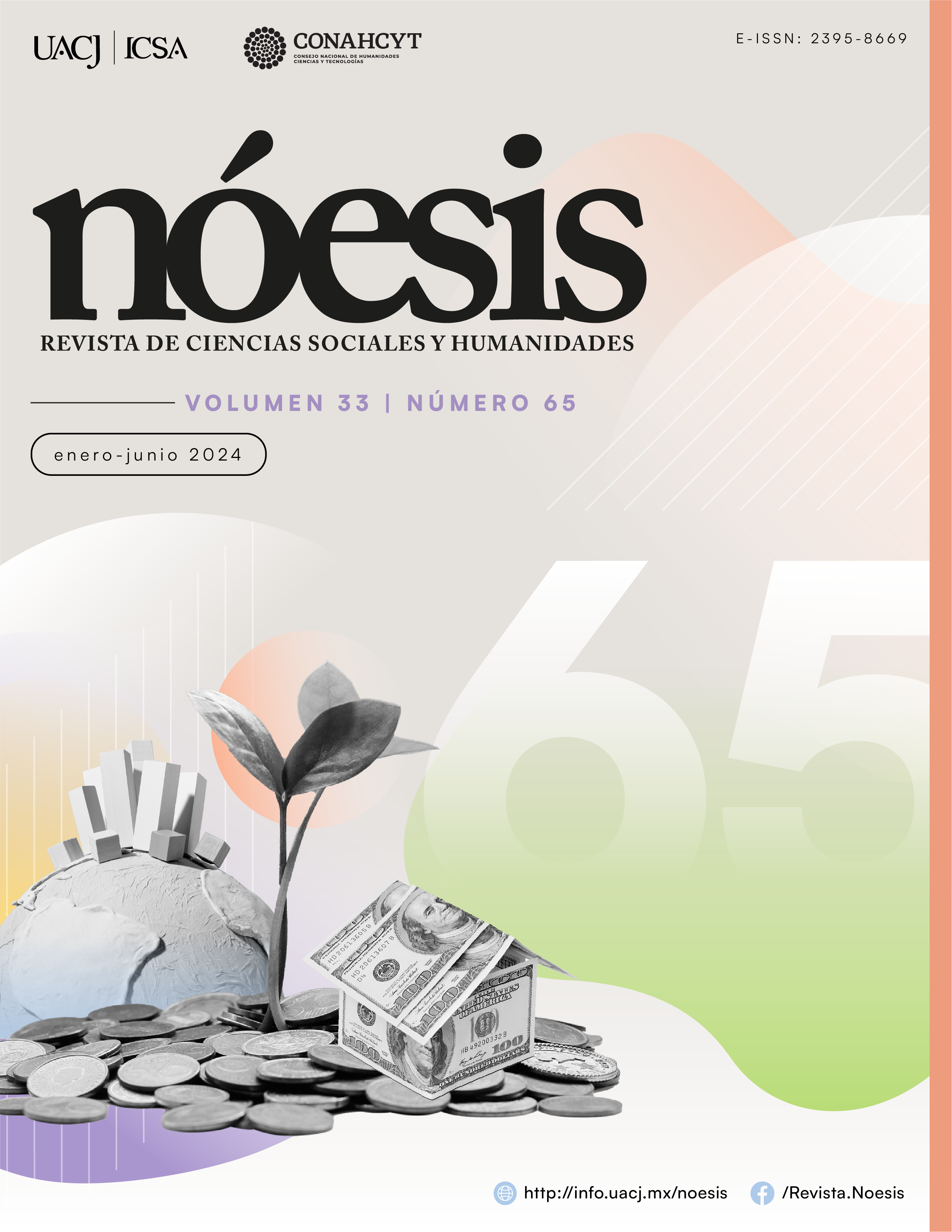Intimate partner violence and its relationship to labor income
Main Article Content
Abstract
In Mexico, 70.1% of women have been victims of violence in their lifetime and the main perpetrator is her intimate partner. Gender violence is a public health problem that has multiple negative impacts in woman and their offsprings. The relation violence and income is an issue that has been scarcely studied for Mexico. The objective of this article is to analyze the intimate partner violence and its relationship to labor income for Mexican women, data used are from the National Survey on the Dynamics of Households Relationships (ENDIREH 2021). The principal component method is used to estimate five kinds of violence; physical, emotional, economic, sexual and, harassment. The instrumental variables method is used to consider the endogeneity of income and violence variables. Except harassment, the results indicate a negative relationship between income and violence. Specifically, sexual violence has the greatest negative effects; women who are victims of sexual violence have an average reduction of 17.4% in monthly labor income. This negative effect represents a loss of just over two month of working days per year and, in the aggregate terms, is equivalent to 0.87% of GDP. The above highlights the importance of orienting public policy actions to work in prevention, attention, punishment and eradications any kind of violence against women.
Downloads
Article Details

This work is licensed under a Creative Commons Attribution-NonCommercial-ShareAlike 4.0 International License.
References
Abramsky, T., Lees, S., Stöckl, H., Harvey, S., Kapinga, I., Ranganathan, M., Mshana, G., & Kapiga, S. (2019). Women’s income and risk of intimate partner violence: Secondary findings from the MAISHA cluster randomised trial in North-Western Tanzania. BMC Public Health, 19(1), 1–15. https://doi.org/10.1186/s12889-019-7454-1
Arceo-Gómez, E. y Campos-Vázquez, R. (2014). Evolución de la brecha salarial de género en México. El Trimestre Económico, 81(323), 619-653. https://doi.org/10.20430/ete.v81i323.125 Agüero, J. (2013). Causal estimates of the intangible costs of violence against women in Latin America and the Caribbean. IDB Working Paper No. IDB-WP-414, 1-33. https://doi.org/10.2139/ssrn.2367687
Aguirre, E. (2023). Violencia doméstica e ingresos laborales de las mujeres en México. Estudios Económicos de El Colegio de México, 38(1), 143–165. https://doi.org/10.24201/ee.v38i1.438
Alonso-Borrego, C., & Carrasco, R. (2017). Employment and the risk of domestic violence: does the breadwinner’s gender matter? Applied Economics, 49(50). https://doi.org/10.1080/00036846.2017.1299103
Angelucci, M. (2008). Love on the rocks: Domestic violence and alcohol abuse in rural Mexico. B.E. Journal of Economic Analysis and Policy, 8(1). https://doi.org/10.2202/1935-1682.1766
Baranov, V., Cameron, L., Contreras Suarez, D., & Thibout, C. (2020). Theoretical underpinnings and meta-analysis of the effects of cash transfers on intimate partner violence in low and middle income countries. Journal of Development Studies, 57(1), 1–25. https://doi.org/10.1080/00220388.2020.1762859
Bobonis, G. J., González-Brenes, M., & Castro, R. (2013). Public transfers and domestic violence: The roles of private information and spousal control. American Economic Journal: Economic Policy, 5(1), 179–205. https://doi.org/10.1257/pol.5.1.179
Covarrubias, A. (2018). Poder, normas sociales y desigualdad de las mujeres en el hogar. Nóesis. Revista de Ciencias Sociales y Humanidades, 27(53), 140–158. https://doi.org/10.20983/noesis.2018.1.7
Dildar, Y. (2021). Is economic empowerment a protective factor against intimate partner violence? Evidence from Turkey. European Journal of Development Research, 33, 1695–1728. https://doi.org/10.1057/s41287-020-00311-x
Dugan, L., Nagin, D. S., & Rosenfeld, R. (1999). Explaining the Decline in Intimate Partner Homicide. Homicide Studies, 3(3), 187–214. https://doi.org/10.1177/1088767999003003001
Fajardo-Gonzalez, J. (2021). Domestic violence, decision-making power, and female employment in Colombia. Review of Economics of the Household, 19(1). https://doi.org/10.1007/s11150-020-09491-1
Guarnieri, E., & Rainer, H. (2018). Female empowerment and male backlash. En CESifo Working Paper No. 7009, SSRN Electronic Journal, 1-40. https://doi.org/10.2139/ssrn.3198483
INEGI. (2018). Estadísticas a propósito del Día Internacional de la Eliminación de la Violencia contra la Mujer (25 de noviembre)/ Datos nacionales. Comunicado de prensa Núm. 588/18. https://www.inegi.org.mx/contenidos/saladeprensa/aproposito/2018/violencia2018_nal.pdf
INEGI. (2022a). Encuesta nacional sobre dinámica de las relaciones en los hogares (ENDIREH) 2021. Comunicado de Prensa, Núm. 485/22. https://www.inegi.org.mx/contenidos/saladeprensa/boletines/2022/endireh/Endireh2021_Nal.pdf
INEGI. (2022b). Sistema Integrado de Estadísticas de Violencia contra las Mujeres. https://sc.inegi.org.mx/SIESVIM1/paginas/consultas/tablero.jsf
INEGI. (2022c). Encuesta nacional sobre la dinámica de las relaciones en los hogares (ENDIREH) 2021: diseño muestral. https://www.inegi.org.mx/contenidos/productos/prod_serv/contenidos/espanol/bvinegi/productos/nueva_estruc/889463907183.pdf
Kibris, A., & Nelson, P. (2022). Female income generation and intimate partner violence: Evidence from a representative survey in Turkey. Journal of International Development, 35(6), 963-978. https://doi.org/10.1002/jid.3713
Knaul, F. M., & Ramírez, M. Á. (2003). El impacto de la violencia intrafamiliar en la probabilidad de violencia intergeneracional, la progresión escolar y el mercado laboral en México. En Caleidoscopio de la Salud: De la investigación a las políticas y de las políticas a la acción, SSRN Electronic Journal,. 69–88. https://ssrn.com/abstract=2053836
Martin, S. L., Moracco, K. E., Garro, J., Tsuia, A. O., Kupper, L. L., Chase, J. L., & Campbell, J. C. (2002). Domestic violence across generations: Findings from northern India. International Journal of Epidemiology, 31(3), 560–572. https://doi.org/10.1093/ije/31.3.560
McClosey, L. (1996). Socioeconomic and coercive power within the family. Gender & Society, 10(4), 449–463. https://doi.org/10.1177/089124396010004006
Rao, V., & Bloch, F. (2002). Terror as a Bargaining Instrument a Case Study of Dowry Violence in Rural India. American Economic Review, 92(4), 1029–1043.
Rivara, F., Adhia, A., Lyons, V., Massey, A., Mills, B., Morgan, E., Simckes, M., & Rowhani-Rahbar, A. (2019). The effects of violence on health. Health Affairs, 38(10), 1622-1629. https://doi.org/10.1377/hlthaff.2019.00480
Vyas, S., & Watts, C. (2009). How does economic empowerment affect women’s risk of intimate partner violence in low and middle income countries? A systematic review of published evidence. Journal of International Development, 21(5), 577–602. https://doi.org/10.1002/jid.1500
World Health Organization. (2019). RESPECT Women: Preventing Violence against Women. https://www.unwomen.org/sites/default/files/Headquarters/Attachments/Sections/Library/Publications/2019/RESPECT-Women-Preventing-violence-against-women-en.pdf
World Health Organization. (2021). Violence against women prevalence estimates, 2018: global, regional and national prevalence estimates for intimate partner violence against women and global and regional prevalence estimates for non-partner sexual violence against women.https://iris.who.int/bitstream/handle/10665/341337/9789240022256-eng.pdf?sequence=1

